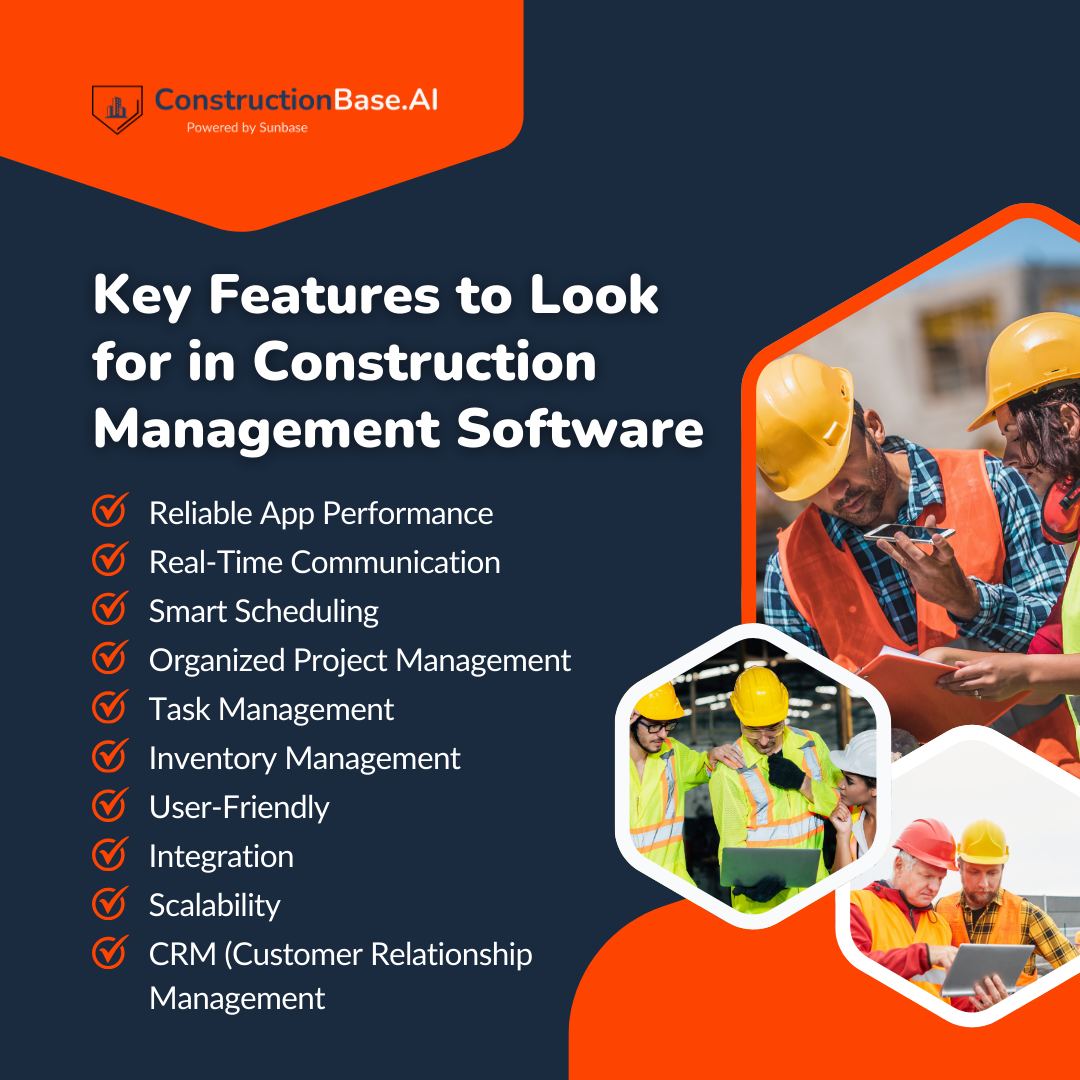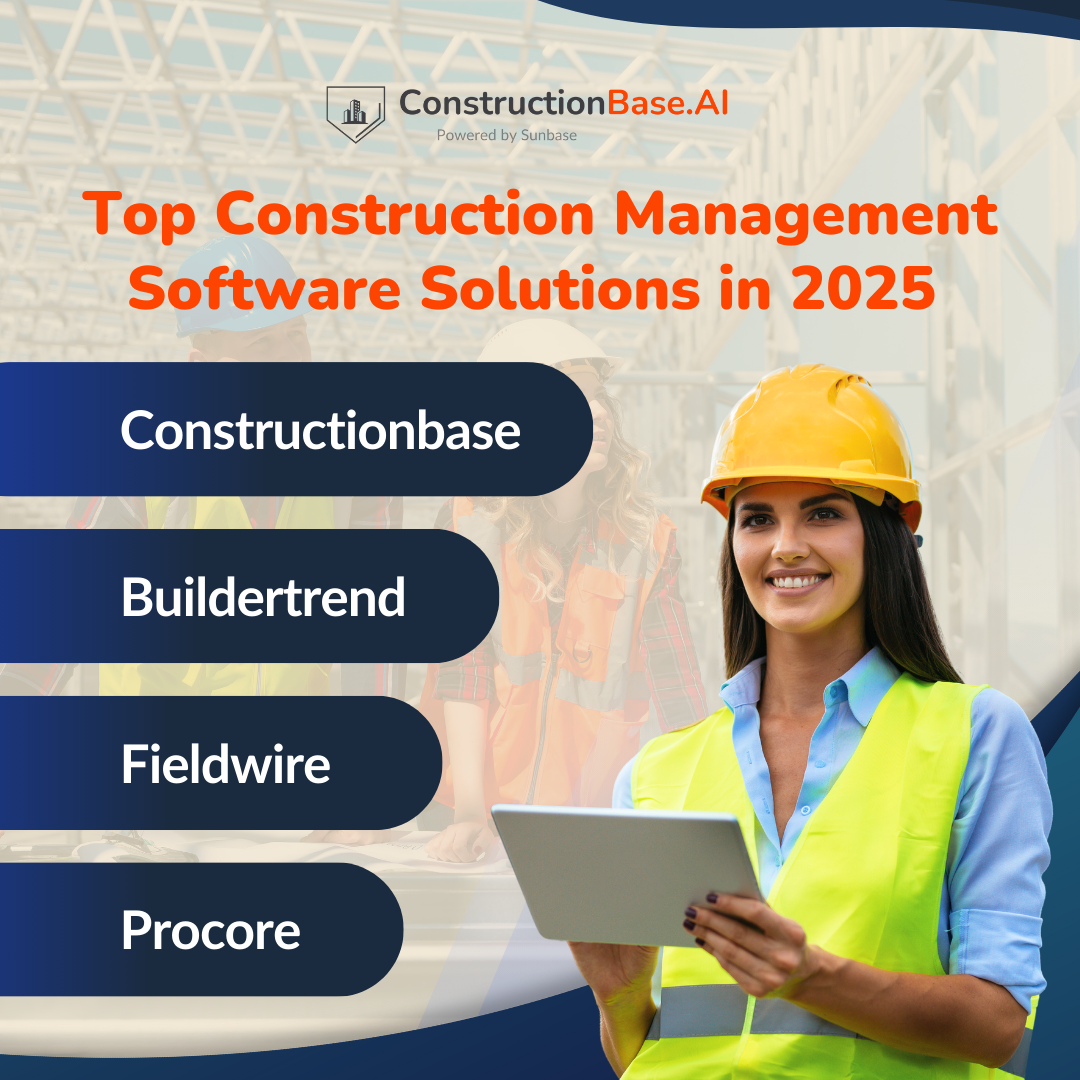You know what’s harder than building a solid foundation? Finding the right software to manage your construction projects.
There’s a lot on your plate: scheduling, budgets, teams, and keeping everyone on the same page. The last thing you need is a tool that complicates things more than it helps.
With so many options out there in 2025, picking the right software can feel like trying to figure out which tool in your kit actually works.
Don’t stress, though. We are here to make it simple. This isn’t just another list of features. We are diving into the best construction management software: what works, where they stand out, and which ones can actually make your life easier.
Let’s cut through the confusion and find the right tool for you. Ready? Let’s go.
Key Takeaways
- Features: Real-time communication, CRM, smart scheduling, inventory management, document management, etc.
- Top construction software: Constructionbase, Procore, Buildertrend, Fieldwire.
- Which one is right for you?: Fit your workflows, plug and play integration, on-the-go access, etc.
Key Features to Look for in Construction Management Software

1. Reliable App Performance
Problem: You have a deadline, you are on-site, and then—BOOM—your app crashes.
Oh, and that loading screen? It’s the only thing moving.
Why it's needed:
- A fast, reliable software that doesn't leave them hanging during critical moments.
- An app that works just as well on-site as it does in the office, no matter how dusty or rainy it gets.
- Something that just works. Period.
2. Real-Time Communication
Problem: Sending messages, hoping someone sees them, but then they don’t reply. It's like you are talking to a wall!!!
No one’s on the same page, and it’s driving you crazy!
Why it's needed:
- Instant communication, with everyone on the same page at the same time.
- Notifications that make sure important stuff doesn’t get lost.
- A platform where everyone can chat, share updates, and work together, no more waiting for responses.
3. Smart Scheduling
Problem: Unexpected things can happen at any time like someone calls in sick, the equipment breaks down, or a storm rolls in.
The schedule can go from perfect to chaotic in a blink.
Why It’s Needed:
- A scheduling system that optimizes crew and equipment based on availability and skills.
- Automatically flags potential scheduling conflicts before they happen.
- A tool that helps plan ahead while giving enough flexibility to adapt without stress.
4. Organized Project Management
Problem: Ever tried to build something without a plan? No right?
Documents everywhere, emails full of random updates, and tasks disappearing. How is anyone supposed to keep track of anything?
Why It’s Needed:
- Keeps everyone on the same page, so you are not constantly wondering, 'Did we even talk about this?'
- Waste of Time? Not anymore. Just organized and easy-to-find info.
- A single spot for all your stuff: tasks, documents, updates, right where you need it.
5. Task Management
Problem: You know that nerve-wracking feeling when things fall apart: tasks pile up, deadlines close, and everyone is confused about what they are supposed to do.
It’s like everyone’s waiting for someone else to take the lead, and suddenly, everything’s a mess.
Why It’s Needed:
- A simple system to keep everyone in the loop and know exactly what’s on their plate.
- Easy-to-use updates, so you always know what’s done and what’s next.
- Tasks are easy to prioritize, so the most important things get done first.
6. Inventory Management
Problem: Running low on materials or tools? Of course, you don’t know until you need them.
Now you have to wait for deliveries or run to the store, which slows everything down.
Why It's Needed:
- Know exactly what you have got, without having to check every time.
- Avoid those annoying delays from not having what you need.
- Quickly spot what needs replacing before it becomes a problem.
Extra features that excite the construction teams:
7. User-Friendly
Problem: If it takes a manual to figure it out, no one will use it. End of story.
Why It’s Needed:
- Clean, simple interface that actually makes sense.
- No training marathons, people can jump in and start using it.
- Saves time, reduces frustration, and keeps the team moving.
8. Integration
Problem: Jumping between five different apps just to finish one task? Copying information from one place to another feels like you're back in 1999.
Why It's Needed:
- Because your tools should work with each other, not against you.
- Everything’s connected, so you don’t waste time doing the same thing twice.
- Updates in one place show up everywhere. Simple. Clean. No extra work.
9. Scalability
Problem: Started small? Great. But now more projects are rolling in, more people are involved, and that “tiny tool that worked back then" just isn’t helping anymore.
Why It's Needed:
- Feels just as simple on day 500 as it did on day 5.
- Handles more jobs, more people, and more data without slowing down.
- Grows with the crew without needing to switch tools every few months.
10. CRM (Customer Relationship Management)
Problem: Keeping track of clients, their needs, and their feedback can get messy quickly.
Why It's Needed:
- Keeps all your client details in one place so you never miss a thing.
- Sends you reminders so you don’t forget to follow up.
- Makes communication way smoother and more personal.
- Helps you stay organized and gives clients a better experience
Explore: The 7 Essential Tools for Construction Managers to Optimize Project Management
Top Construction Management Software Solutions in 2025

Here's a glance
1. Constructionbase
An all-in-one platform that simplifies and unifies the entire construction process, enabling teams to efficiently manage projects from start to finish within a single, integrated system.
Features:
- Project Management: Keep everything organized from start to finish in one place.
- Material Takeoffs: Instantly get accurate material lists to avoid mistakes.
- Project Tracking: Track progress, deadlines, and resources in real-time.
- Estimating & Bidding: Quickly create accurate estimates and bids.
- Scheduling: Adjust timelines and tasks easily as the project moves.
- Team Collaboration: Share updates and tasks with your team and clients.
- Resource Management: Monitor labor, materials, and equipment usage.
- CRM: Manage leads, interactions, and follow-ups to boost sales and client relationships.
- Reports & Insights: Get real-time reports on budget, progress, and more.
Best For:
Construction project managers, general contractors, field teams and site supervisors, architects and engineers, construction company owners and executives.
Integrations:
QuickBooks, Google Drive, MailChimp, Google Calendar, etc.
Scalability:
Grows with your business. Whether managing one project or dozens, it’s built to support small teams or large enterprises without slowing down.
Mobile Accessibility:
Stay connected from anywhere. Works on iPhone and Android.
With the mobile app, teams can view schedules, upload photos, and manage tasks directly from the job site, even without an internet connection.
2. Procore
Procore is a cloud-based software that helps connect everyone involved in a construction project. It offers a complete solution for managing projects, including tools for project management, financials, and field productivity.
Features:
- Document Management: Store all plans in one place with version control, OCR, and linked RFIs, submittals, and documents.
- Task Management: Track project progress, manage crew schedules, and connect with accounting tools.
- Site Management: Use mobile tools to update site progress, upload photos and videos, and manage your workforce in real-time.
- Reporting & Analytics: Use daily reports and custom dashboards to monitor costs, materials, and productivity.
Best For:
- Builders, contractors, subcontractors, project managers, and property owners.
- Companies managing projects of varying complexity and size.
Pros:
- Mobile-friendly – iOS and Android apps make it easy for field teams
- Customizable reporting
- Integration with AutoCAD and Revit
- No limits on users, files, or photos – add as many team members and documents as needed
Cons:
- Learning curve for new users; training is required
- No upfront pricing
Pricing:
- Starts at $375/month
- Unlimited Users & Data: All plans include unlimited users, data storage, and 24/7 support.
- No free version, but a 14-day free trial is available
Integrations
It connects over 500 out-of-the-box integrations you use from the Procore App Marketplace.
Scalability
Grows with your business from small teams to large, global operations.
Mobile App
Works on iPhone and Android so that you can check project info anywhere.
View files and plans without an internet connection; changes sync when you're back online.
3. Buildertrend
Buildertrend is a cloud-based construction software that simplifies workflows, boosts communication, and organizes documents. Its easy interface and mobile app let teams work from anywhere.
Its mission is to support the ongoing success of your construction business. Users often praise its strong support, helpful training, and ease of use.
Features:
- Scheduling: Plan timelines, assign tasks, and auto-update when things change.
- Daily Logs: Write down what got done each day. Add photos or notes so there's always a record of progress.
- Reports & Analytics: Get insights on costs, progress, and performance.
- Materials Management: Track inventory, costs, and supplier deals.
Best For:
- Home builders, remodelers, specialty contractors, and small to mid-sized construction companies.
Pros:
- Continuous improvements
- Enhanced client communication
- User-friendly interface
Cons:
- Complicated features
Pricing:
Essential Plan
- Regular Price: $499/month
- First-Month Discount: $300 off – pay only $199
- Includes all the core tools you need: scheduling, to-dos, proposals, and a customer portal.
Advanced Plan
- Regular Price: $799/month
- First-Month Discount: $300 off – pay only $499
- Adds advanced tools like estimating, financial tracking, takeoffs, and change orders.
Complete Plan
- Regular Price: $1,099/month
- First-Month Discount: $300 off – pay only $799
- Gives you everything: selections, warranties, RFIs, detailed reports, and everything from the lower plans.
Integrations:
- QuickBooks – Two-way sync for job costing, invoicing, and payments.
- Xero – Syncs financials, invoices, and bills.
- Home Depot Pro Xtra – Order and track materials (Advanced & Complete plans)
Scalability:
Grows with businesses, whether just starting out or managing multiple builds.
It supports unlimited users and projects, making it suitable for companies of all sizes.
Mobile App On the Job Site:
The app works on iPhone and Android. It lets your team:
- Check and update schedules.
- Upload photos and videos on-site.
- Log updates using voice-to-text.
- Submit warranties without leaving the job.
4. Fieldwire
Fieldwire is a cloud-based construction app built for field teams. It helps everyone from the job site to the office stay on the same page by making it easy to share updates, track work, and stay organized throughout the project.
Features:
- Task Management – Assign tasks, track progress, and use checklists.
- Real-Time Collaboration – Chat and get updates instantly with push notifications.
- Punch Lists & Inspections – Track issues with photos and videos.
- Scheduling & Reporting – Schedule tasks and create custom reports.
Best For:
General contractors, specialty contractors, owners, architects, and designers.
Pros:
- Easy to use with a great interface for tracking progress and billing on job sites
- Makes it simple to manage and monitor multiple sites remotely
Cons:
- Syncing between phone and computer can be slow, especially in a hurry.
- Limited features on low-cost plans
Pricing:
Basic Plan:
- Price: Free
- Up to 5 users.
- 3 projects.
- 100 sheets.
- Core features include task management, plan viewing, and file sharing.
Pro Plan:
- Monthly(per user): $54
- Annually(per user): $39
- All basic features, custom task statuses, reports & exports, and sheet comparison tools.
Business Plan:
- Monthly(per user): $74
- Annually(per user): $59
- All pro features, custom forms, integrations, and a BIM viewer.
Business Plus Plan:
- Monthly(per user): $104
- Annually(per user): $89
- All business features, RFI's, submittals, change orders, and budget.
Integrations:
- Google Drive: Sync plans and files for field access.
- Microsoft Teams: Get real-time form updates.
- Google Sheets: Analyze tasks across projects.
- ON! Track: Sync projects and job site locations.
Scalability:
Scales effortlessly from small teams to billion-dollar projects.
It supports 10 to 10,000 users with unlimited projects and sheets on paid plans, making it ideal for both small firms and large enterprises.
Mobile App:
Work offline on iOS and Android with auto-sync.
Learn: Optimize, Automate, and Excel: Comprehensive Construction Software to Empower Your Team
Which Construction Software Is the Right One For You?
| Softwares | Project Management | Task Management | Client relationship management | Resource Management | Scheduling | Estimating and Bidding | Team Collaboration | Reports and Insights | Scalability | Integration | Mobile Accessibility |
|---|---|---|---|---|---|---|---|---|---|---|---|
| Constructionbase | ✓ | ✓ | ✓ | ✓ | ✓ | ✓ | ✓ | ✓ | ✓ | ✓ | ✓ |
| Procore | ✓ | ✓ | - | ✓ | ✓ | ✓ | ✓ | ✓ | ✓ | ✓ | ✓ |
| Buildertrend | ✓ | ✓ | ✓ | ✓ | ✓ | ✓ | ✓ | ✓ | ✓ | ✓ | ✓ |
| Fieldwire | ✓ | ✓ | - | ✓ | ✓ | - | ✓ | ✓ | ✓ | ✓ | ✓ |
1. Fit Your Workflow
Consider how your team operates on a day-to-day basis.
Does the software adapt to your needs, or do you have to adapt?
Go for something that feels like a natural extension of your team.
2. Plug & Play Integration
You have already got systems in place.
Look for software that fits your existing workflow, like it was meant to be there.
Integration should be effortless, whether it's connecting to your accounting, scheduling, or design tools.
3. Easy Peasy Learning Curve
No one has time for long tutorials or complex manuals.
You need an intuitive solution that gets your team working fast and lets you “set it and forget it” with minimal setup time.
4. On-the-Go Access
Construction never sleeps.
Whether you are on-site or at the office, choose software that keeps you and your team in the loop, anytime, anywhere.
Mobile access is a must!
5. Future-Proof Scalability
As your projects grow, you want software that grows with you.
Don’t lock yourself into something that doesn’t scale.
Find a solution that’s flexible and ready for anything.
6. The Price is Reasonable
Sure, budget is important, but think long-term.
Will this software save you time and money in the future?
Look for something that balances cost with features and gets the most bang for your buck.
At the end of the day, the right construction software depends on what you need.
Knowing your priorities makes all the difference, whether full-suite management or just smoother scheduling and communication.
That’s why we broke things down to help make your decision much easier.
Go Through: Automating Construction Workflows with AI-powered Business Management Software
Conclusion
Alright, wrapping it up!
Picking the right project management software for your construction projects can make life easier.
With so many solid construction management software options in 2025, you will be on track to complete projects faster, stay organized, and keep things running smoothly.
It’s all about finding the right tools to help you do the job!
About Constructionbase
Want to crush it in construction in 2025?
Constructionbase has your back with the tools you need to make every project smoother, smarter, and more efficient. Let’s build the future, join us today!
Frequently Asked Questions
1. What is the benefit of scalable construction software for growing businesses?
Scalable construction project management software grows with your business, allowing you to track progress across multiple projects and ensure your team can handle larger workloads as your construction business expands.
2. Is construction software suitable for different project sizes?
Yes, construction software is flexible and scalable, suitable for both small and large projects. It helps construction managers track progress and manage resources, regardless of the project size.
3. How do custom task statuses help construction project managers prioritize tasks?
Construction project managers can categorize tasks by priority, progress, and dependencies with custom task statuses. This ensures that the most critical tasks are completed first, leading to smoother project progress and on-time completion.
Have questions or need personalized advice?
Talk to an Expert Today and let our construction specialists guide you to success.







